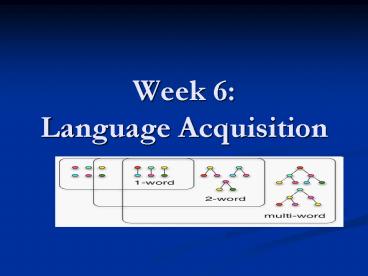Week 6: Language Acquisition - PowerPoint PPT Presentation
1 / 18
Title: Week 6: Language Acquisition
1
Week 6Language Acquisition
2
The object of study
- Language acquisition is the study of the
processes through which humans acquire language. - By itself, language acquisition refers to first
language acquisition, which studies infants'
acquisition of their native language, whereas
second language acquisition deals with
acquisition of additional languages in both
children and adults.
3
Language and communication
- It is a commonly held view that language evolved
as a tool for communication. - 1. Human language can be seen primarily as a
socially, or culturally determined tool for
communication. - 2. Alternatively, language can be seen primarily
as a cognitive mechanism for structuring
utterances and perhaps also thoughts.
4
Acquiring language
- One of the complexities of acquiring language is
that it is learned by infants from what appears
to be very little input. - This has led to the long-standing debate between
the two different groups of scholars
5
- Nativist theories Chomky is the preeminent name
hereplace the distinctiveness of language in
specific genetic endowment for a specifically
genetically instructed language module. Under
that view, there is minimal learning involved in
acquiring a language. - Empiricists like Hobbes and Locke argued that
knowledge emerge ultimately from abstracted sense
impressions.
6
- The precise form of language must be acquired
through exposure to a speech community. Words are
definitely not inbron, but the capacity to
acquire language and use it creatively seems to
be inborn. N. Chomsky calls this ability the LAD
(Language Acquisition Device).
7
Co-evolutionary theory
- There are also co-evolutionary proposals
Language is not an instinct and there is no
genetically installed linguistic black box in our
brains. Language arose slowly through cognitive
and cultural inventiveness. - Language began as a cognitive adaptation and
genetic assimilation. Cognitive effort and
genetic assimilation interacted as language and
brain co-evolved.
8
- Human language is made possible by special
adaptations of the human mind and body that
occurred in the course of human evolution, and
which are put to use by children in acquiring
their mother tongue
9
A Critical Period forLanguage Acquisition
- Critical Period Hypothesis Exposure to language
- before puberty is necessary for language
acquisition. - Children with delayed exposure to languageThe
Wild Boy of Aveyron. Genie - Sample utterances by Genie
- Mike paint.
- Applesauce buy store.
- Small two cup.
- I like hear music ice cream truck.
- Think about Mama love Genie.
10
Milestones inLanguage Development
- Language Stage
Beginning Age - Crying!
Birth - Cooing!
6 weeks - Babbling!
6 months - Intonation patterns!
8 months - One-word utterances!
1 year - Two-word utterances!
18 months - Word inflections!
2 years - Questions, negations!
2 1/4 years - Rare and complex constructions! 5
years - Mature speech!
10 years
11
Pre-Verbal LanguageDevelopment
- Crying Non-linguistic Though some language
specific elements. - Cooing Non-linguistic. Exercising the
articulatory apparatus. Imitation and the
beginning of turn-taking. - Babbling here infants are clearly producing
syllable like sounds. No meaning attached to the
babble. Syllables are often found in repetitive
sequences (babababa). Children clearly utilise
their babling to tune their vocalisation to the
sounds of the local language. - Babbling as part of the biologically determined
maturation of language abilities. - Babbling drift Around 9-14 months infants
restrict their babbling to native language
sounds.
12
First words
- Shortly before their first birthday, babies begin
to understand words, and around that birthday,
they start to produce them. Words are usually
produced in isolation this one-word stage can
last from two months to a year. - Children's first words are similar all over the
planet. About half the words are for objects
food (juice, cookie), body parts (eye, nose),
clothing (diaper, sock), vehicles (car, boat),
toys (doll, block), household items (bottle,
light), animals (doggie, kitty), and people
(mama, dada, baby). - There are words for actions, motions, and
routines, like (up, off, open, peekaboo, eat, and
go, and modifiers, like hot, all gone, more,
dirty, and cold.
13
The Influence of Experienceon Phonological
Processing
14
Lexical Development
- Children start producing their first words around
12 - months.
- Words are used holophrastically A word stands
for - an entire sentence.
- By 24 months they have an expressive vocabulary
of - between 50 to 600 words.
- Experience matters for vocabulary growth.
- Privileged children hear about 2,100 words/hour.
- Disadvantaged children hear only about 600
words/hour.
15
Syntactic Development
- 18-24 Months Two-word utterances
- 95 of utterances Correct word order.
- Telegraphic speech (few function words).
16
Syntactic Development
- How do children fit long thoughts into two word
utterances? - Children appear to use vertical constructions of
- utterances (Moskowitz, 1991).
- Breaking thoughts down into two-word utterances.
- Child Tape corder. Use it. Use it.
- Adult Use it for what?
- Child Talk. Corder talk. Brenda talk.
- Adults use horizontal constructions.
- - Complete word-by-word specification of thoughts.
17
- 24-48 Months Complexity and length of utterances
increase rapidly. gt normal conversation. - How do children achieve this rapid increase in
sentence complexity and length? - .
18
Childish creativity
- Despite the obvious impact the environment has on
the - choice and general direction of mother-tongue
learning, - children are prone to come up with all kinds of
words - and expressions which they have never heard in
their - environment.
- Daughter Somebodys at the door.
- Mother There is nobody at the door.
- Daughter There is yesbody at the door.





























